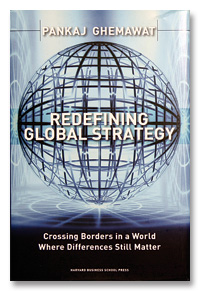Best Business Books 2008: Strategy
Fast Competition and Flat Denial
(originally published by Booz & Company)
William P. Barnett
The Red Queen among Organizations: How Competitiveness Evolves
(Princeton University Press, 2008)
Sea-Jin Chang
Sony vs. Samsung: The Inside Story of the Electronics Giants’ Battle for Global Supremacy
(Wiley, 2008)
Pankaj Ghemawat
Redefining Global Strategy: Crossing Borders in a World Where Differences Still Matter
(Harvard Business School Press, 2007)
As in the past, many of the books about strategy published in the last year employ a familiar set of buzzwords. They advise us to “think big,” to “outsmart,” and to “break through”; they urge us to “break the rules,” “change the game,” and strive for speed, agility, and focus.
Managers may find a useful idea or two in each of these books, but few of them are fundamentally persuasive or insightful. Most are long on admonition and exhortation — Be innovative! Be bold! — but short on critical thought. Many suffer from a fatal flaw: They feature companies that have achieved remarkable performance — whether great success or colossal failure — and then explain those outcomes using simplistic ex post facto rationalizations. In doing so, they fail to appreciate the real uncertainties facing managers as they make decisions. And they ignore the fact that it is just as easy to select a handful of successful companies and conclude that they prevailed through dogged persistence and focus as it is to pick a set of companies whose success seems to be based on their willingness to scrap the conventional and do something radically different. After the fact, it’s always possible to tell one story or the other.
As for words like agility and resilience, they describe wonderfully aspirational qualities that also tend to be observable only in hindsight. Show me any successful company, and I can make a case that it is agile and resilient; show me any less-successful company, and I can argue that it lacks those qualities. But unless we can define these concepts as we observe them, rather than infer them from past performance, they provide little more than retrospective storytelling. Which is not a bad way to describe many strategy books.
Corporate strategists deserve better, and the good news is that 2008 saw the publication of a number of strategy books that are in fact better. For the past two years, the focus of strategy+business’s essay on best strategy books was growth. But strategy is fundamentally about choices made in a competitive setting, and this year, a few books bring competition back to center stage.
 Red Queen Competition
Red Queen Competition
The most ambitious and important new strategy book is The Red Queen among Organizations: How Competitiveness Evolves, by William P. Barnett, a professor at Stanford University’s Graduate School of Business. The book’s central image comes from Lewis Carroll’s classic children’s story Through the Looking-Glass, in which the Red Queen explains to Alice that in her country, “it takes all the running you can do, to keep in the same place.”
The driving mechanism of Red Queen competition is straightforward. “Organizations learn in response to competition, making them stronger competitors and so triggering learning in their rivals,” writes Barnett. Thus, performance is relative to competition, not absolute. A company can run faster and fall farther behind at the same time. Despite our fondest wish to achieve high performance by following a simple formula — and despite the dozens of strategy books that cater to that desire — the realities of Red Queen competition are starkly different.
Barnett identifies two of these realities: “The threatening effects of current-time competition, and the viability-enhancing effects of hysteretic competition.” (Hysteretic refers to systems that, like thermostats, are slow to switch back to their previous state after a stimulus has been removed.) The danger of competition is obvious: the greater its intensity, the greater the threat to survival. But the benign effect of competition is also important, although often overlooked: “Organizations with more exposure to a recent history of competition are more viable and generate stronger competition.” The central insight of Red Queen competition is that through competition itself, firms learn about rivals, about customers, and about the competitive context — and therefore become stronger. Yet as companies become stronger, rivals learn from one another and emulate the leader’s winning ways, leading to a narrowing gap between the best and the rest. That’s the nature of Red Queen competition — companies have to run faster to avoid falling behind.
How then should a company pursue a strategy? In a riposte to so many formulaic books, Barnett writes: “There is no one best strategy. Rather, organizations must perform better than their rivals according to the context’s logic of competition.” What works best is context-specific; change the context and the company’s performance will vary. Some competitive contexts may be coarse-grained — the results of competition are relatively few and far between but of huge consequence, such as winning or losing a contract for a new airplane or a bid for a major construction project. Others may be fine-grained, with payoffs that are frequent but less consequential, such as merchandising a consumer product in a narrow geographic region. But whatever the competitive context, explains Barnett, “winning and losing in competition depends on whether organizations are well adapted to the specific competitive logic that prevails in their contexts.”
Barnett does not underestimate the uncertainty that managers face in understanding their competitive contexts or the difficulties inherent in having to make inferences quickly on limited samples. “If, with the benefit of large samples seen in hindsight, those who study organizations face indeterminacy, then even greater uncertainty is faced by those who manage organizations,” he writes. “After the fact, we can look back over the evidence of an industry’s history and recount with greater clarity the various logics of competition as they have unfolded. Before the fact, however, these logics are yet to be discovered.”
Barnett’s view of fitness through competition is borne out by sound and extensive analysis of two very different industries: commercial banking and computers. Through an empirical analysis of commercial banks in the state of Illinois over many years, based on extensive archival data, Barnett shows that banks that had been exposed to intense competition became stronger competitors. The same pattern is found in the computer business: In several industry segments — mainframes, minicomputers, and microcomputers — manufacturers discovered ways of matching technologies with customer needs through the process of competition itself. Observes Barnett: “The logic of competition that we would come to understand in each market was discovered by competing.” As for the performance implications, it turns out that computer manufacturers with greater exposure to competition were also the ones more likely to survive.
Barnett’s findings have profound managerial implications. Many recent strategy books urge managers to change the game, to search for blue oceans free of competitors, or otherwise to escape the rigors of competitive rivalry. But as this author says, “Managers busily pursuing a strategy of isolation are especially challenged by this theory. If exposure to competition is what generates capabilities, then the strategy of differentiation in order to minimize competition is called into question.” Analogies from sports often miss the mark in business, but here they seem apt. Competition brings out the best in athletes — and in companies. Records are set not in practice, but in head-to-head confrontations where rivals spur one another to do their best.
If isolating oneself from competition is not wise, surely the opposite is not recommended, either — walking into the buzz saw of intense competition, where companies have little ability to differentiate their offerings. Presumably the lesson for managers is to steer a middle path, but Barnett does not offer many guidelines for action here.
Furthermore, when the logic of competition changes, capabilities that were essential in one environment may prove to be less so in another — or even prove to be counterproductive. Thus, Barnett offers up the notion of a firm getting caught in a competency trap — becoming so well adapted to a given competitive context that it is unable to adapt when the game changes. He also raises the idea that seeking to break out of existing markets and apply experience elsewhere may not be very effective. Managers may think their experience will help them thrive in new markets and conditions, when in fact the opposite is likely to be the case.
The Red Queen among Organizations is written in a style that is more academic than practical. Its main thrust is theoretical, and the full implications for managers will likely not be drawn out for a few years. Nevertheless, it is the best strategy book of the year because of its main insights: Competition concerns relative performance, not absolute performance; a company’s competitiveness is context specific, and contexts can change, giving rise to the competency trap; learning comes about from competing, not isolation from competition; and differentiation is desirable as a way to secure rents, but must be pursued in the context of competition, not in the vain hopes of avoiding it.
A Tale of Two Competitors
For an in-depth account of a specific competitive battle, a laudable book is Sony vs. Samsung: The Inside Story of the Electronics Giants’ Battle for Global Supremacy, by Sea-Jin Chang, professor at Korea University in Seoul (and my Wharton classmate and research partner in the 1990s). Chang paints a detailed portrait of Japan’s Sony Corporation and Korea’s Samsung Corporation as they engaged in a complex game of cooperation and competition.
Chang’s approach differs from most not only because he had superb access to senior executives in both companies, but because he refrains from easy inferences based on performance outcomes. He begins by citing articles from leading business magazines that acclaimed Sony’s brilliance in 1999, only to blast CEO Nobuyuki Idei as one of the worst managers just a few years later. Chang knows that people don’t become that stupid that quickly — and refuses to engage in the simplistic blame games that characterize so many books.
Through interviews and the analysis of company data, Chang tracks the strategies, organizational processes, and leadership styles of both companies. He demonstrates how Sony’s strategy and organizational processes were well suited to analog technologies, to which companies added value through imaginative new products. At the same time, during the 1980s and early 1990s, Samsung was little more than a component manufacturer, and unable to compete effectively against Sony. But as the rules of the game shifted in the late 1990s with the move to digital technologies, Samsung began to excel in a competitive context that rewarded low-cost components, while Sony struggled with a strategy that aimed to combine content with hardware. Further, Sony’s superiority in televisions was lost when cathode ray tube technology gave way to liquid crystal display flat screens, in which Samsung has now also overtaken Sony. Thanks to its strong position in components, Samsung passed Sony in market capitalization by 2002, and by 2006 was twice as valuable as Sony, leading its Japanese rival in both sales and profitability.
Chang concludes that the recent performance differences between Sony and Samsung were not purely the result of their different strategies, but reflected the fit between those strategies and the companies’ organizational processes and leadership. There was nothing wrong with Sony’s strategy per se, but Sony was unable to execute that strategy owing to ill-suited organizational processes and political infighting. Chang may be correct. After all, Apple has been able to succeed using a substantially similar strategy.
But another explanation is possible, as well: It may be that Sony’s inability to adapt its organizational processes is not unusual, but indeed almost predictable. Organizations often change more slowly than their environments, meaning that in time most organizations become unfitted to their new contexts. That is, of course, very much the notion of the competency trap described by Barnett in The Red Queen among Organizations, and raises the question of whether success in one context tends to lead to failure in another.
Seen through this lens, the story of Sony and Samsung, rather than being the tale of one company’s decline and another’s rise, is one more illustration of a general tendency for high performance to fall over time. Thus, some years ago Sony was praised not only for its strategic vision but for its ability to devise organizational processes to execute that strategy; some years from now, when a new generation of technology or a different competitive context is in place, Samsung may well be eclipsed by a new rival. Although we may justifiably applaud Samsung for its recent successes, we should bear in mind that the same elements that lead to success may sow the seeds of failure when the competitive context shifts.
 The Global Context
The Global Context
The battle between Sony and Samsung highlights the increasingly global nature of competition, a subject ably addressed in Redefining Global Strategy: Crossing Borders in a World Where Differences Still Matter, by Pankaj Ghemawat, professor at IESE in Barcelona. (See “Pankaj Ghemawat: The Thought Leader Interview,” by Art Kleiner, s+b, Spring 2008.) To the current crop of authors who assert that the world is now “flat,” this title is a cogent reminder that global strategy concerns choices that are made in a more complex world.
Ghemawat argues that the world is better described as “semiglobalized,” and claims that it is precisely the differences among countries that provide opportunities for any global strategy to create value. National differences, he says, exist along four dimensions: cultural, administrative, geographic, and economic. Further, the importance of these dimensions can differ by industry. For example, geography and culture may matter little in the semiconductor industry, but for the food industry the implications of these two dimensions are massive. Once these national differences as they exist in a given industry are understood, firms can identify ways to add value through the dispersion and coordination of global activities, whether by adding revenues, decreasing costs, managing risk, or leveraging expertise.
Ghemawat describes three ways that multinationals can deliver the benefits of a global strategy: by capturing benefits of scale through aggregation; by securing benefits of local adaptation; or through a mix of both, called arbitrage. Readers familiar with the work of Christopher Bartlett and Sumantra Ghoshal, notably their landmark book, Managing across Borders: The Transnational Solution (Harvard Business School Press, 1989) will find similarities here — aggregation and adaptation are similar to global integration and local responsiveness, respectively, and arbitrage has a ring similar to the notion of transnational management. Yet by offering an updated framework to analyze global strategy, Ghemawat’s work is useful and practical. Indeed, it is the best treatment on the subject of global strategy to appear for quite some time, and is a much-needed antidote to the simplistic treatments of flat-world management that are currently in vogue.
Redefining Global Strategy is a reminder that an effective strategy is not a blueprint that can lead to guaranteed success. Rather, strategy is making choices that will improve the chances of success — and having to constantly make new choices to differentiate oneself from rivals in a bruising competitive terrain that is well described as Red Queen competition.
If the fortunes of Sony and Samsung, and other global companies, are subject to the inexorable logic of Red Queen competition, what are the implications for corporate strategists? Is any success, however brilliant it may seem today, fated to regress to some industry mean? Inevitably, the discussion comes back to words like agility and resilience, and to the ability of a company to force itself toward renewal so that it might thrive in new contexts.
Not surprisingly, several current books claim to tell companies how to be agile. But none of them made this list of best books, because they all fall into the common trap of selecting a successful company and then attributing its success, in retrospect, to something that they call “agility.” To date, there is little work on agility or resilience that does not suffer from this sort of rationalization. Competition may be the topic of leading strategy books in 2008, but if these books are right — if competition can be described as a Red Queen race in which capabilities that lead to success in one time period become a trap that makes subsequent success less likely — then one would hope that next year we will feature high-quality books about agility and resilience. Although it may be impossible to defy gravity forever, devising actions that might forestall the erosion of performance should be of interest to all strategists. ![]()
Author profile:
Phil Rosenzweig is a professor at IMD in Lausanne, Switzerland, where he works with leading companies on questions of strategy and organization. He is the author of The Halo Effect...and the Eight Other Business Delusions That Deceive Managers (Free Press, 2007).

